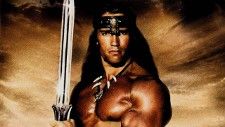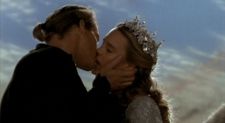
A 21st century vision of Conan the Barbarian
In the dim and distant past, when men were real men and films were shot on real film, the height of escapist entertainment was the pulp novel and its cousin, the adventure comic. Many mighty heroes graced the pages of these sensational publications, flexing their thews and slaying assorted monsters in order to save scantily-clad noblewomen from diabolical villains. Mightiest of them all was Conan of Cimmeria. Now that he's returning to the screen in a brand new form, it's worth looking back at his dramatic past and his many associates and imitators.
Conan creator Robert E Howard was a modest man, a highly capable writer but not one who ever set out to create great art. His mother suffered from tuberculosis and he spent most of his adult life as her carer, selling pulp fiction in order to keep a roof over their heads. Shy and not much given to physical activity, he was the antithesis of the hero who went on to be such a success. Though Conan, who always manage to spend or misplace his own treasures, never made Howard a fortune, he clung on in the popular imagination and became a cult figure, leading to millions of book, comic and film ticket sales over the 79 years since his first appearance.
A muscular warrior whose remarkable strength and fighting prowess are matched by his humour, cunning, and wariness about his weaknesses, Conan was always going to be a difficult character to cast for the cinema. Few actors could ever look the part, let alone play it. Yet the character was a screen natural. This was recognised in the Seventies by creative all-rounder Edward Summers, who struggled to find support for a script that was faithful to its source. Eventually Oliver Stone came on board to make the script more cinematic and John Milius stepped in to direct. They found their star in Arnold Schwarzenegger, then most famous for Hercules In New York. He was a former Mr Universe who knew how to do little more than grunt and pose and perform simple slapstick routines, but his naivety was in many ways well suited to the character and he proved a remarkable success.

With a thundering soundtrack by Basil Poledouris and a memorable villain in James Earl Jones' Thulsa Doom, Conan The Barbarian was a superior piece of filmmaking that stands up well to this day. It was originally intended to be the first of a six part series, though Milius only committed to three. Unfortunately its successor, Conan The Destroyer, was not as strong, despite a remarkable supporting performance by Grace Jones, who has never been better cast. Schwarzenegger's star was rising and he had been offered the leading role in a new science fiction thriller, Predator, so the Conan project fell through making it with somebody else would at that time have been unthinkable.
With Conan no longer an option, attention turned to another of Howard's barbarian heroes, Red Sonja. Originally appearing in a short story. Sonja had been fleshed out by comic writer Roy Thomas, who gave her a new lease of life in the comics of the early Seventies. To succeed on the big screen she needed the support of Schwarzenegger, who agreed to play a supporting role. Sonja herself was played by newcomer Brigitte Nielsen, a model who was completely out of her depth when it came to acting but whose remarkable muscular physique at least helped her to convince as a warrior. Though the film was not well received by critics, it assured Nielsen a career in B-movies (plus an affair with Schwarzenegger and, later, marriage to his muscle-movie rival Sylvester Stallone). It also helped to confirm the sword and sorcery movie as something with real cult appeal. Despite initially suffering serious losses at the box office, it has played well on television (and video, and DVD) ever since.
Every successful film has its imitators. Once the formula of questing muscular hero plus sword plus scantily clad women plus evil villain was established, these came thick and fast. Hawk The Slayer stayed close to the Conan films in style, whilst The Beastmaster expanded the magical themes and added telepathy and animal antics. At the bottom of the budget ladder, Yor combined the sword and sorcery setting with scenes liberally lifted from Star Wars. By contrast, Krull had a huge budget and an impressive amount of talent on board, but failed miserably at the box office. Ridley Scott's take on the genre, Legend, brought it closer to the stuff of fairy tales and secured enduring cult status largely thanks to the scenery-chewing performance of Tim Curry in a giant rubber suit with horns. Meanwhile, the remains of the third Conan film were adapted into Kull The Conqueror, with yet another Howard character taking the lead, this time played by future Hercules Kevin Sorbo.
By the mid-Eighties, the fantasy star was starting to fade and the beefcake look was on its way out, increasingly the subject of comedy rather than admiration. Still, occasional sword and sorcery films popped up over the years that followed. 1986's Highlander gave the genre a contemporary twist by following Christopher Lambert's immortal hero into the present day. With Sean Connery doing his utmost to lend it gravitas, Clancy Brown going gloriously over the top as villain The Kurgan and Queen providing a memorable soundtrack, the film became a cult hit, spawning several rather less noteworthy sequels and a television series. In 1988, Willow saw Val Kilmer take on the role of the warrior hero, reluctantly helping little people to rescue a baby destined for sacrifice by an evil queen. Although it wasn't as successful as its creators (including George Lucas) had hoped, the film did make money and made a star of Kilmer, who also went on to marry his co-star Joanne Whalley. Sequels were discussed but never came to fruition. Between these films came Rob Reiner's celebrated spoof The Princess Bride.
Sword and sorcery films have been few and far between over the last two decades, with The Lord Of The Rings dominating the fantasy film market but allowing little room for barbarian heroes. Several attempts were made to develop King Conan, a project focusing on the character later in his life, but fell apart largely because Schwarzenegger was busy being Governor of California. An animated version of the hero's story, Conan: Red Nails has also been sitting in development hell for years; if it ever happens, it is likely to feature the voice of Ron Perlman.
Now that the new Conan The Barbarian is in cinemas, with Game Of Thrones star Jason Momoa in the title role, audience appetites will once again be whetted. Although they are well suited to spectacular budgets, films of this sort can be made very cheaply indeed, so success for Momoa could see a new army of barbarians at the box office. Steel yourself. You never know what fate may have in store.





















